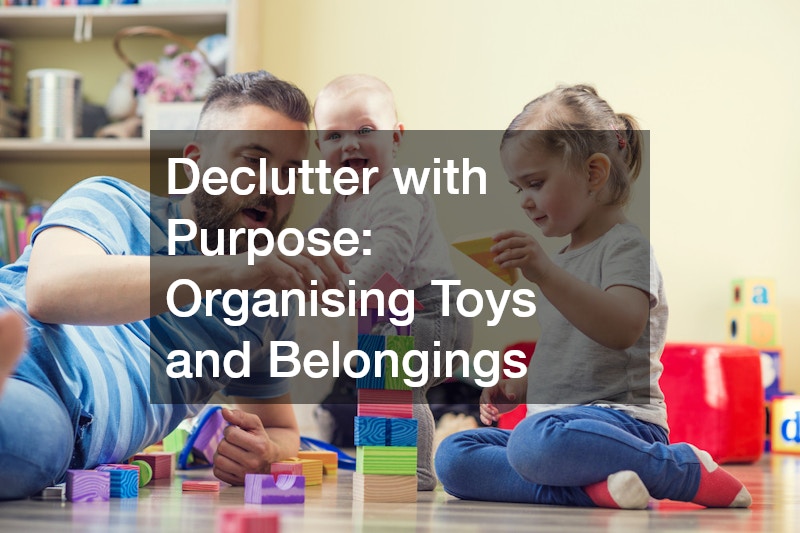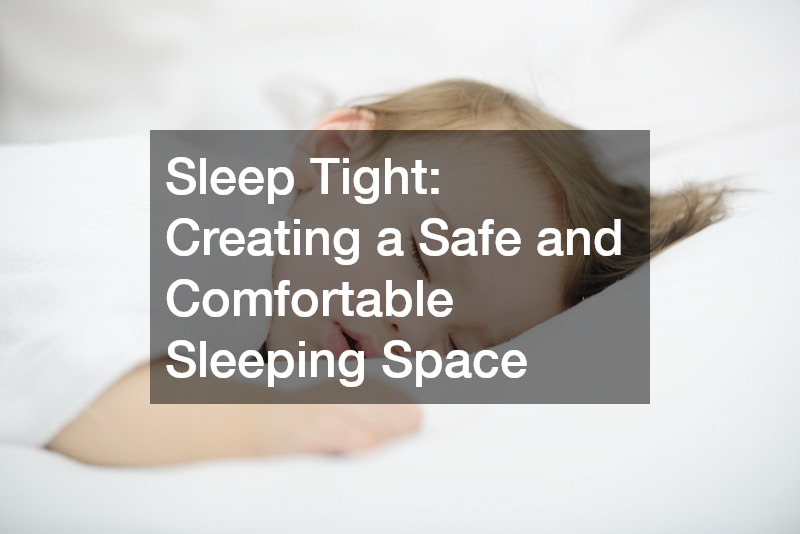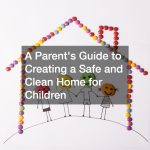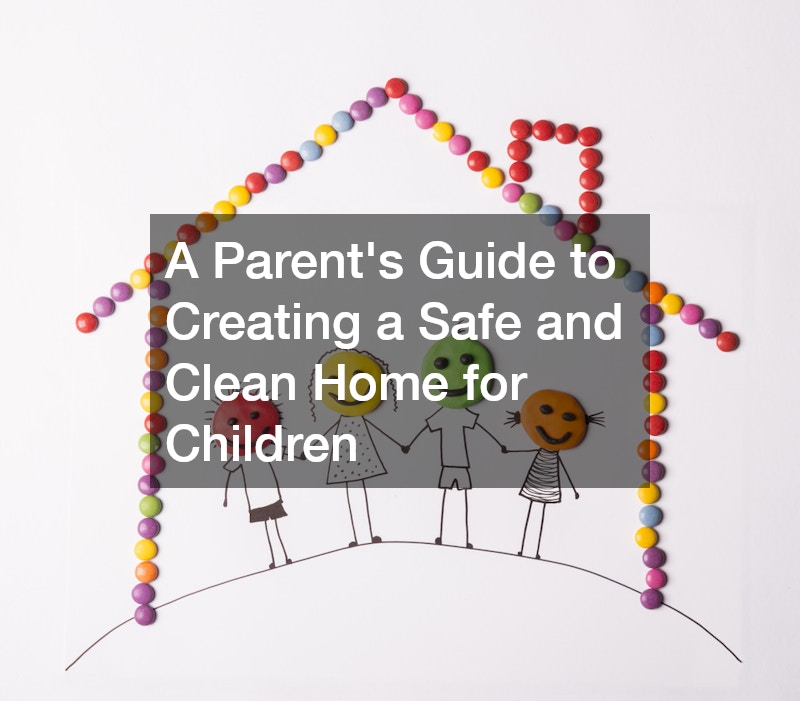Every parent’s top priority is to provide a clean and safe home environment for their children. This involves more than simply cleaning up. It requires proactive measures and thoughtful planning to prevent accidents and promote well-being. From organising toys to maintaining a haven for children to thrive, each step contributes to a home that is a secure place. This guide provides practical tips for maintaining cleanliness and safety in your home. It covers everything from emergency preparation and indoor air to regular inspections. Implementing these strategies will help you create a safe and healthy environment for your children.
It is important to keep your home clean and safe, especially if you have kids. Well-maintained and organised environments not only promote their well-being but also their safety. Children are curious and energetic by nature, so they explore their environment a lot. It is, therefore, important to create an environment that is both clean and secure. You can create a safe home for your children by implementing practical strategies and routines. This article will give you simple yet effective tips on how to keep your house clean and safe for your kids.
Declutter with Purpose: Organising Toys and Belongings

Toys and other belongings should be kept organised to maintain a safe and clean home. To create a clutter free environment, designate specific storage areas for your toys. Bins and shelves make it easy to access and clean, so you can find your favourite toys and store them.
Teach your children to put away their toys when they are done playing. It not only helps keep the home tidy, but it also instills in children good habits from a young age. If your garage door is often used by the family as an entrance, you might want to consider setting up a small storage area next to it. So, the children can easily drop off and pick up their outdoor playthings, keeping the home more organised.
Encouraging your children to use a designated space for their toys can keep your home cleaner and safer.
Childproofing Done Right: Securing Your Home for Curious Explorers
Installing childproofing in your home will ensure that your children are safe as they play and explore. Install safety gates on the top and bottom steps to prevent accidents. These gates are barriers that keep children away from dangerous areas. Consider using automatic gates for extra convenience and safety. These gates can be opened easily by adults but are secure against curious children’s hands.
Another important step is to cover electrical outlets with safety plugs. Children are curious and can try to put objects in the outlets. This is dangerous. Safety plugs reduce the risk of electric shocks by blocking access.
It is crucial to secure heavy appliances and furniture to the wall. Bookcases, dressers and even water heaters should be securely anchored in order to prevent them from falling over. Furniture is often used by children to help them climb or pull themselves up. Unsecured items can be a danger.
These childproofing steps will create a safe environment for your children to play and explore.
Cleanliness Counts: Establishing Daily Routines
A clean home is the result of a consistent effort and a well-structured approach. A daily routine for cleaning up will help you keep your home organised and reduce clutter. This can include tasks like putting toys away, organising books and wiping surfaces.
To minimise the spread and transmission of germs, surfaces that are frequently touched, such as light switches, doorknobs and counters, should be regularly cleaned. This task can be made easier by using disinfectant sprays or wipes. Consider hiring a carpet cleaning service to clean your carpets and rugs thoroughly, so they stay fresh and free of allergens.
It can be a big help to involve children in cleaning chores that are age-appropriate. Instilling a sense of responsibility in children by teaching them to do simple chores like dusting or picking up toys helps maintain cleanliness. You can also use drain cleaners on a regular basis to ensure that sinks and baths are always free of clogs. This will help maintain a clean environment.
You can keep your house clean and safe by establishing regular cleaning habits and involving everyone in the family.
Kitchen Safety First: Storing and Preparing Food Wisely
It is important to maintain a healthy environment in the home, especially when there are children present. Store cleaning supplies and sharp items out of reach. To prevent accidents or accidental ingestion, store these items high up in cabinets or locked drawers.
Another effective measure is to install child locks in kitchen cabinets. These locks will prevent children from getting to dangerous items such as knives or chemical cleaners. This ensures that your kitchen is a safe place.
Always wash your hands after handling food and before preparing it. This simple act reduces the chance of cross-contamination and maintains hygiene. Keep your kitchen surfaces like granite counters clean and sanitised for a safe place to prepare food.
Inspect your kitchen periodically for signs of pests. Contact a pest control company to resolve any problems you may have. It is important to keep pests away from food in order to maintain a safe and clean environment.
Bathroom Bliss: Keeping It Clean and Safe
It is important to keep your bathroom clean, especially if you have children. Keep toiletries and cleaning supplies locked up. To prevent accidental ingestion of harmful substances or contact, store these items in cabinets that have childproof locks.
To reduce the chance of a fall, ensure that your bathmats do not slip. Mats with suction cups or rubber backing that stick firmly to the floor are best. This preventive measure helps to keep both adults and children safe in the bathroom.
All bathroom surfaces, including sinks and toilets, should be cleaned and disinfected regularly. This prevents germs from building up, creating a cleaner environment. Do not forget to check and maintain the septic tank on a regular basis. This will ensure that it is working properly and does not pose any health hazards.
Implementing these practices will help you maintain a safe, clean and hygienic family bathroom.
Sleep Tight: Creating a Safe and Comfortable Sleeping Space

It is important to create a safe environment for your child when they are sleeping. Use bedding and sleepwear that are age-appropriate. To ensure your child sleeps safely and soundly, choose materials that are suitable and comfortable for their age.
Remove toys and blankets from the crib. These items may pose a suffocation risk to infants. Use fitted sheets or sleep sacks to keep your baby warm and safe at night.
Check regularly for recalls and inspect the crib for any signs of wear. Check for recalls regularly and inspect your crib for signs of wear. To prevent accidents, secure all screws and bolts.
Installing window treatments that block out excess light will help your child sleep. Regular maintenance by AC professionals of your home’s HVAC system can help ensure a safe and comfortable sleeping environment.
Following these guidelines will help you create a sleeping area that is safe, comfortable and conducive for your child.
Healthy Habits Start at Home: Hygiene Tips for Kids
It is important to instil healthy habits and hygiene practices into children. This will improve their health. It is important to teach children how to wash their hands frequently, especially before meals and when they use the bathroom. This will help prevent the spread of germs. To ensure efficacy, proper handwashing techniques should be stressed, including using soap and scrubbing your hands for at least twenty seconds.
It is important to encourage regular dental and bathing routines. Bath time can be made fun to cultivate a habit. Brushing teeth twice daily is also important for oral health, and reducing the risk of gum disease and cavities. These practices do not only help to keep children clean, but also boost their immune system and protect them from common infections.
Hand sanitisers are a great alternative to soap and water when they’re not available. This habit emphasises the importance of cleanliness and hygiene in places where germs are common, like schools or public areas. Parents can encourage their children to develop healthy habits by incorporating these practices into their daily routines.
Stay Ready: Emergency Preparedness for Families
To ensure your family’s security, you must be prepared for any emergency. Maintaining a first aid kit that is easily accessible and stocked with the essentials such as bandages, antiseptic wipes, pain relievers, etc., is a crucial step. The kit should be stored in a well-known location, and the supplies should be checked regularly.
It is also important to teach children how they can respond in an emergency. Make sure they know how to call emergency services provide their address and any relevant information. By making mock emergency calls, they can become familiar with the process. This will also instill confidence.
Create an emergency escape plan for your family and practice it regularly. Establish a meeting place outside and identify the primary and alternate exit routes for each room. Regularly practice drills to reinforce the procedures and ensure everyone knows where to go in case of an emergency.
Breathe Easy: Monitoring Indoor Air Quality
Air quality in your home directly affects the health of you and your family. Use air purifiers with HEPA filters for allergens and pollution to maintain good indoor air. These filters perform best when they are regularly changed.
Smoking indoors can cause secondhand smoke to be harmful, causing respiratory problems and other health issues, especially in children. Smokers should smoke outside and away from doors and windows to reduce indoor contamination.
Open windows when the weather permits to encourage natural ventilation. Fresh air circulation can reduce indoor pollutants and help maintain a healthy environment. This is particularly beneficial when performing activities such as cleaning or cooking that produce airborne particles.
Preventive Care: Regular Inspections and Maintenance
Regular inspections and maintenance are essential for a home to be safe and efficient. Test smoke and carbon dioxide detectors monthly, and replace batteries as necessary. These detectors alert you to fires and dangerous gas leaks in advance, protecting your family.
Regularly inspect children’s toys, household furniture and other items for signs of wear. To prevent injuries, such as falls or choking hazards, repair or replace damaged objects immediately.
Schedule regular maintenance of household systems, including heating, cooling, and plumbing. Professional inspections prevent breakdowns, and ensure that these systems are operating safely and efficiently. Early detection of minor problems can save you money on repairs and maintain your home’s comfort.
You can improve the functionality, safety and health of your home by incorporating these practices in your daily routine.
The Bottom Line
To maintain the cleanliness and safety of a house with children, you need to be diligent and committed. Implementing the tips in this guide into your daily life will not only improve the safety of your home, but also create a nurturing and healthy environment for your entire family. Each action, whether it is establishing an organised toy collection, childproofing the home, or instilling good hygiene habits in your family, plays a vital role in creating a safe and comfortable atmosphere.
This effort is not complete without proactive measures for emergency preparedness and regular inspections. Routine checks are essential to ensure that safety devices such as smoke alarms and childproofing tools work correctly. Practising emergency evacuation plans will reinforce preparedness and ensure that everyone is able to react effectively in critical situations.
In addition, promoting good indoor air through the use of air purifiers or ventilation will not only improve your health but also increase comfort in your home. These proactive measures contribute to an environment that is conducive to children’s development and growth without exposing them to unnecessary health risks.
By investing in these practices and maintaining a proactive attitude toward home safety and cleaning, you can create a safe haven for your children to grow, learn, and thrive. Your efforts will reap long-lasting benefits for your children’s development and well-being.




